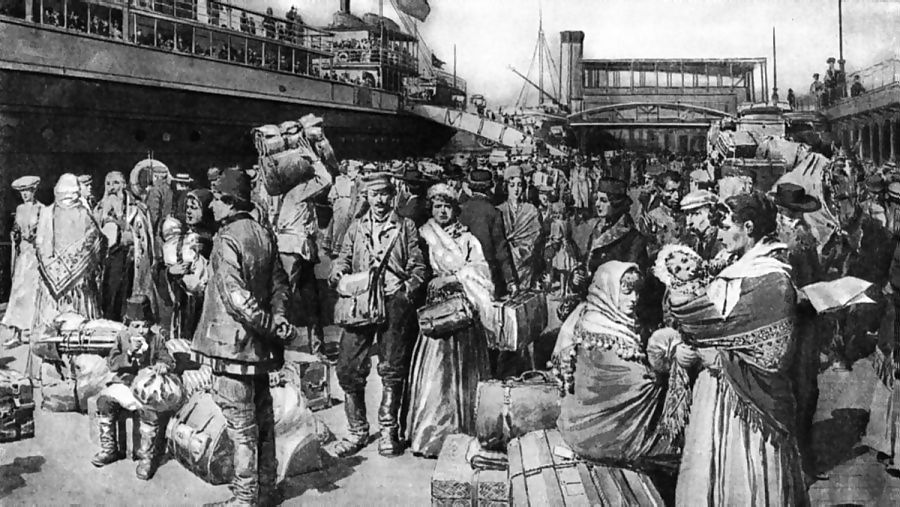Even though the Irish had immigrated to America in the colonial times, their mass emigration was most prevalent in the early to mid-19th century.
A large surge in emigrations can be noticed in the early 19th century, adding to a total of 4, 5 million immigrants spanning from 1820 to 1830. This first wave in the 19th century was a product of religious conflicts, lack of political autonomy and dire economic conditions. They were often referred to as “Scotch-Irish” and despite looking for luck over the pond they often ended up in the same conditions they previously dodged.
Later, the process was heavily influenced by The Great Irish potato famine (1845-1852). It affected the entirety of the country, however it hurt the south and west Ireland the worst especially in the year 1847 (Black ’47) when around 1 million people left their home country to move to America. In some towns up to 67% of the population emigrated in the time from 1841-1851, however overall, roughly 20-25 % of the population left the country.

In the forty years the massive emigration lasted Irish people composed roughly one third of immigrants to America, with a sudden spike in the forties when they were one half of the arrived foreigners.
| Year | Population | % change | av % per year |
| 1891 | 4.7m | 9, 27 | 0,93 |
| 1881 | 5.18m | 4, 07 | 0,4 |
| 1871 | 5.4m | 6, 9 | 0,69 |
| 1861 | 5.8m | 11, 45 | 1, 15 |
| 1851 | 6.55m | 19,93 | 1, 95 |

Upon arriving, America did not receive them well, as most were viewed very poorly and had to try to bur the divide by creating new Irish American traditions such as St. Patrick’s Day.
Mostly they were settled in slums near the ports they arrived on, cramming together in attics and basements with no water, sanitation, or daylight. As city resources went to the immigrants (the population of Boston skyrocketed for 30 % with the 37,000 newcomers), most people of America didn’t feel particular sympathy. Because of such poor conditions, they were willing to work for any money at all, which lead to unskilled American’s fearing them taking up jobs.
Besides pure nationalistic prejudice, a large sum of prejudice was linked to their religion. American Protestants believed that because of their dedication to the Pope, they could never be true Americans and marked them in the newspapers as “aliens” or “mindless”. With that many job offers were followed by the “No Irish Need Apply” sings and texts at the bottom.
Because of the discrimination they needed to stay together in ghettos and closely knit religious communities, they built schools and churches. By the 1860s amongst the Civil war, America’s eyes shifted from the Irish to the Anti-slavery movement and the prejudice was slowly let go off. The Know-Nothing Party” formed in the fifties, which urged to prevent further Irish immigration split up and lost following.
After the passing of the Civil war, many Irish people could find jobs much easier, now working in factories, mines, and railroads. They lead strikes to heighten the pay and shorten the workday, later becoming more involved with the general politics- usually in the Democrat Party. A highly popular new branch of work was helping new immigrants adjust to the life in America, however now those immigrants expanded to Italians, Poles and Jews as well. Now leaving the ghettoes they went to Catholic high schools and later to colleges. Mostly the fields they were in were spread far and wide: medicine, law, and business.

By the beginning of the 20th century about 15 % wee unskilled workers, however to the 1920s there was no noticeable difference between the Irish and American population.
Today Irish Americans remember their roots in the Irish heritage month (March), which is celebrated in all of the states and has been a reoccurring event since 1991. In the month on the 17th Saint Patrick’s Day (Irish name: Lá Fhéile Pádraig) is celebrated in honor of the patron saint of Ireland. It is celebrated with traditional Irish music, dances, parades, beer, and the mandatory copious amounts of green.
Sources:
https://www.bbc.co.uk/bitesize/guides/zcyymnb
https://en.wikipedia.org/wiki/Great_Famine_(Ireland)
https://en.wikipedia.org/wiki/Irish_population_analysis
This video was prepared in the frame of the “The Heart of a City” project funded by ACF Slovenia. Read more about the project.



